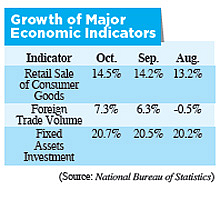|
A more sound economy
Future economic growth in China mainly depends on the soundness of the Chinese economy itself. Since 2007, China has launched a strategic campaign of economic restructuring.
Five years later, this campaign has greatly moved forward and the economy become a lot sounder.
Zhang says one change is that consumption has been a larger contributor to economic growth than investment. In the first nine months this year, the proportion of consumption to total GDP was 55 percent, while that of investment was 50.5 percent.
"Regarding economic development in the first three quarters, domestic demand made a contribution of 105.5 percent, while external demand was negative at 5.5 percent. We should place emphasis on development to expand domestic demand, which has the potential to maintain steady and fast economic growth," said Zhang.
He adds that 42 detailed rules have been formulated this year to promote private investment. Thus far, the proportion of private investment has already reached 62 percent, indicating that the private economy has achieved rapid development.
NDRC statistics also show that the structure of primary, secondary and tertiary industries is more coordinated.
"In the industrial sector, the proportion of strategic emerging industries and hi-tech industries is increasing and the transformation of traditional industries is accelerating. The proportion of tertiary industry continues to rise," said an NDRC release.
As for urban and rural development, China's urbanization rate (ratio of urban population among total population) reached 51.3 percent in 2011.
Rural infrastructure construction, basic public services, tap water supply, electricity, roads, gas and housing in rural areas, as well as farmers' production and living conditions, have all been greatly improved.
"Although there are still many problems, such as excessive production and extensive management in some industries, that need to be solved, we will enhance efforts to implement various policies and measures and quicken our pace in transforming the economic growth mode," Zhang said.
Pressure remains
According to Zhang, in the NDRC's analysis, the foundation for an economic rebound is not firm enough.
"Under the background of a slow global economic recovery and an ongoing financial crisis, we must be prepared for difficulties and challenges in the long run," said Zhang.
Qin Xiao, Council Chairman of Boyuan Foundation, said at the China Capital Innovation Summit held on November 13 that basic factors propping up China's economic growth are changing.
First, China is currently in the middle and late stages of industrialization. The "catching-up" growth that relies on extensive input has reached its end, but present systems, human resources and the level of technology have not shown that China has the conditions and capability to leap over the middle-income trap and enter an "innovation- oriented society."
Second, after 30 years of sustained and rapid progress, China's urbanization has begun to slow down. The average annual urbanization growth rate is set to drop to 0.8 percent during the 12th Five-Year Plan period (2011-15) from 1.35 and 1.45 percent during the ninth and 10th five-year plan periods (1996-2005), respectively. The impetus for economic growth brought by urbanization is weakening.
Moreover, since 2007, the number of migrant workers has been declining despite increasing wages. Some coastal cities are even suffering a shortage of migrant workers. All this indicates that a time of infinite labor supplies has passed. Together with the arrival of an aged society, the "demographic dividends" that China has long enjoyed is almost over.
"Significant changes of even the most basic factors will affect China's economic growth," Qin said.
According to Qin, the potential of future economic growth depends on systematic reform. At present, three major economic reforms are needed: a relaxation of monopoly, financial reform and income distribution reform.
Relaxing monopoly will solve the problem of inadequate effective supplies, income distribution reform will solve the problem of inadequate demand, and financial reform will improve efficiency in resource allocation.
"If the three reforms can be effectively advanced, the market and financial resource allocation problems that restrict the Chinese economy will be effectively solved, consumption potential will be fully realized and the Chinese economy will hopefully step out of its present predicament," Qin said.

Email us at: lanxinzhen@bjreview.com | 